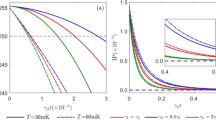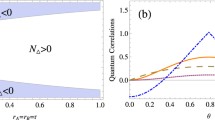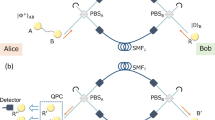Abstract
In this paper, we show how Einstein–Podolsky–Rosen-like entanglement between a pair of spatially separated propagating continuous-mode Gaussian fields can be generated via a coherent feedback loop that connects two spatially distant nondegenerate optical parametric amplifiers (NOPAs) over two transmission channels. In particular, the scheme generates entanglement in a distributed manner using spatially distributed resources. It is shown that similar to a single NOPA, the coherent feedback scheme has parameters that determine the achievable frequency-dependent two-mode squeezing and entanglement bandwidth between the pair of continuous-mode fields. It is also shown that in ideal scenarios, the feedback connection is able to yield an increase in the quality of the entanglement while consuming less power, compared to conventional distribution of entanglement using a single NOPA and a two-cascaded NOPA system. Furthermore, in contrast to the two conventional systems, under the same pump power, the coherent feedback system provides more entanglement in the presence of transmission losses, which indicates that the feedback scheme increases tolerance to transmission losses.













Similar content being viewed by others
Notes
Note that [4] and the formula (6) takes \(\xi ^q_{\mathrm{out},a}-\xi ^q_{\mathrm{out},b}\) and \(\xi ^p_{\mathrm{out},a}+\xi ^p_{\mathrm{out},b}\) as the squeezed two-mode quadratures rather than \(\xi ^q_{\mathrm{out},a}+\xi ^q_{\mathrm{out},b}\) and \(\xi ^p_{\mathrm{out},a}-\xi ^p_{\mathrm{out},b}\), respectively. To obtain squeezing in the latter quadratures, as in this paper, in the single NOPA one need only take \(\epsilon <0\) and the formula (6) is modified to be \(V_{\pm }(0)= 2\frac{(1+k)^2}{(1-k)^2}\).
References
Braunstein, S.L., Loock, P.: Quantum information with continuous variables. Rev. Mod. Phys. 77, 513–577 (2005)
Briegel, H.J., Dr, W., Cirac, J.I., Zoller, P.: Quantum repeaters: the role of imperfect local operations in quantum communication. Phys. Rev. Lett. 81, 5932–5935 (1998)
Sangouard, N., Simon, C., Riedmatten, H., Gisin, N.: Quantum repeaters based on atomic ensembles and linear optics. Rev. Mod. Phys. 83, 33 (2011)
Ou, Z.Y., Pereira, S.F., Kimble, H.J.: Realization of the Einstein–Podolsky–Rosen paradox for continuous variables in nondegenerate parametric amplification. Appl. Phys. B 55, 265 (1992)
Zhang, G.F., James, M.R.: Quantum feedback networks and control: a brief survey. Chin. Sci. Bull. 57(18), 2200–2214 (2012)
Mabuchi, H.: Coherent-feedback quantum control with a dynamic compensator. Phys. Rev. A 78, 032323 (2008)
Iida, S., Yukawa, M., Yonezawa, H., Yamamoto, N., Furusawa, A.: Experimental demonstration of coherent feedback control on optical field squeezing. IEEE Trans. Autom. Control 57(8), 2045–2050 (2012)
Hamerly, R., Mabuchi, H.: Advantages of coherent feedback for cooling quantum oscillators. Phys. Rev. Lett. 109, 173602 (2012)
Hamerly, R., Mabuchi, H.: Coherent controllers for optical-feedback cooling of quantum oscillators. Phys. Rev. A 87, 013815 (2013)
Crisafulli, O., Tezak, N., Soh, D.B.S., Armen, M.A., Mabuchi, H.: Squeezed light in an optical parametric oscillator network with coherent feedback quantum control. Opt. Express 21(15), 18371–18386 (2013)
Yan, Z., Jia, X., Xie, C., Peng, K.: Coherent feedback control of multipartite quantum entanglement for optical fields. Phys. Rev. A 84, 062304 (2011)
Nurdin, H.I., Yamamoto, N.: Distributed entanglement generation between continuous-mode Gaussian fields with measurement-feedback enhancement. Phys. Rev. A 86, 022337 (2012)
Gardiner, C., Collett, M.J.: Input and output in damped quantum systems: quantum stochastic differential equations and the master equation. Phys. Rev. A 31(6), 3761–3774 (1985)
Waals, D.F., Milburn, G.J.: Quantum Optics. Springer, Berlin (1994)
Gardiner, C.W., Zoller, P.: Quantum Noise, 3rd edn. Springer, Berlin (2004)
Belavkin, V.P., Edwards, S.: Filtering and optimal control, pp. 143–205. Quantum Stochastics and Information - Statistics, Filtering and Control (2008)
Wiseman, H.M., Milburn, G.J.: Quantum Measurement and Control. Cambridge University Press, Cambridge (2010)
Vitali, D., Morigi, G., Eschner, J.: Single cold atom as efficient stationary source of EPR-entangled light. Phys. Rev. A 74, 053814 (2006)
Gough, J.E., James, M.R., Nurdin, H.I.: Squeezing components in linear quantum feedback networks. Phys. Rev. A 81, 023804 (2010)
Gerry, C.C., Knight, L.: Introductory Quantum Optics. Cambridge University Press, Cambridge (2005)
He, W.-P., Li, F.-L.: Generation of broadband entangled light through cascading nondegenerate optical parametric amplifiers. Phys. Rev. A 76, 012328 (2007)
Yan, Z., Jia, X., Su, X., Duan, Z., Xie, C., Peng, K.: Cascaded entanglement enhancement. Phys. Rev. A 85, 040305(R) (2012)
Jacobs, B.C., Pittman, T.B., Franson, J.D.: Quantum relays and noise suppression using linear optics. Phys. Rev. A 66, 052307 (2002)
Michiels, W., Niculescu, S.I.: Stability and Stabilization of Time-Delay Systems: An Eigenvalue-Based Approach. SIAM, Advances in Design and Control (2007)
Engelborghs, K., Luzyanina, T., Samaey, G.: DDE-BIFTOOL vol. 2.00: A Matlab Package for Bifurcation Analysis of Delay Differential Equations. Technical report TW-330, Department of Computer Science, Katholieke Universiteit Leuven, Leuven, Belgium (2001)
Engelborghs, K., Luzyanina, T., Roose, D.: Numerical bifurcation analysis of delay differential equations using DDE-BIFTOOL. ACM Trans. Math. Softw. 28(1), 1–21 (2002)
Di Loreto, M., Dao, M., Jaulin, L., Lafay, J.-F., Loiseau, J.J.: Applied interval computation: A new approach for time-delays systems analysis. In: Chiasson, J., Loiseau, J.J. (eds.) Applications of Time Delay Systems, pp. 175–197. Springer, Berlin (2007)
Author information
Authors and Affiliations
Corresponding author
Rights and permissions
About this article
Cite this article
Shi, Z., Nurdin, H.I. Coherent feedback enabled distributed generation of entanglement between propagating Gaussian fields. Quantum Inf Process 14, 337–359 (2015). https://doi.org/10.1007/s11128-014-0845-4
Received:
Accepted:
Published:
Issue Date:
DOI: https://doi.org/10.1007/s11128-014-0845-4




